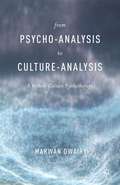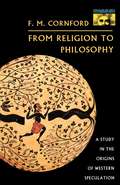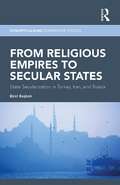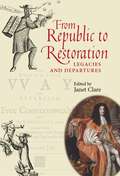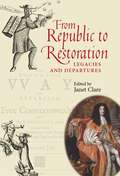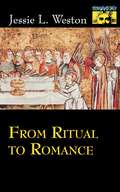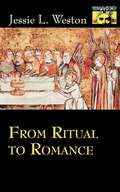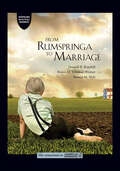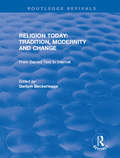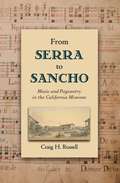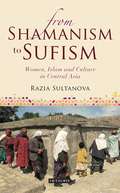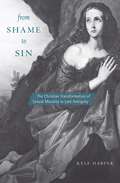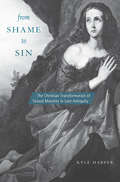- Table View
- List View
From Presumption to Prudence in Just-War Rationality (Routledge Studies in Religion)
by Kevin CarnahanFor the last several decades, the Just-War debate amongst theologians has been dominated by two accounts of moral rationality. One side assumes a presumption against harm (PAH), and the other identifies with a presumption against injustice (PAI). From Presumption to Prudence in Just-War Rationality argues that the time has come to leave behind these two viewpoints in favour of a prudentially grounded approach to Just-War thinking. In Parts 1 and 2 of the book, Kevin Carnahan offers immanent critiques of the PAI and PAH positions. In Part 3, utilising Paul’s treatment of the atonement and use of the idea of the imitation of Christ, he lays out an alternative to the ways in which theologians in favour of the PAI or PAH have construed the Christian narrative. In Part 4, Carnahan then develops a neo-Aristotelian account of prudence as a higher order virtue governing the interpretation of moral reality. Drawing on this account, he explores what Just-War rationality would look like if it were prudentially grounded. The work concludes with a case study on noncombatancy in the 2011 Israeli bombardment of Gaza. This book offers a compelling new perspective on this important and pertinent subject. As such, academics and students in Religion, Theology, Philosophy, Ethics and Political Theory will all find it an invaluable resource on Just-War theory.
From Presumption to Prudence in Just-War Rationality (Routledge Studies in Religion)
by Kevin CarnahanFor the last several decades, the Just-War debate amongst theologians has been dominated by two accounts of moral rationality. One side assumes a presumption against harm (PAH), and the other identifies with a presumption against injustice (PAI). From Presumption to Prudence in Just-War Rationality argues that the time has come to leave behind these two viewpoints in favour of a prudentially grounded approach to Just-War thinking. In Parts 1 and 2 of the book, Kevin Carnahan offers immanent critiques of the PAI and PAH positions. In Part 3, utilising Paul’s treatment of the atonement and use of the idea of the imitation of Christ, he lays out an alternative to the ways in which theologians in favour of the PAI or PAH have construed the Christian narrative. In Part 4, Carnahan then develops a neo-Aristotelian account of prudence as a higher order virtue governing the interpretation of moral reality. Drawing on this account, he explores what Just-War rationality would look like if it were prudentially grounded. The work concludes with a case study on noncombatancy in the 2011 Israeli bombardment of Gaza. This book offers a compelling new perspective on this important and pertinent subject. As such, academics and students in Religion, Theology, Philosophy, Ethics and Political Theory will all find it an invaluable resource on Just-War theory.
From Priest's Whore to Pastor's Wife: Clerical Marriage and the Process of Reform in the Early German Reformation
by Marjorie Elizabeth PlummerOn 13 June 1525, Martin Luther married Katharina von Bora, a former nun, in a private ceremony officiated by city preacher Johann Bugenhagen. Whilst Luther was not the first former monk or Reformer to marry, his marriage immediately became one of the iconic episodes of the Protestant Reformation. From that point on, the marital status of clergy would be a pivotal dividing line between the Catholic and Protestant churches. Tackling the early stages of this divide, this book provides a fresh assessment of clerical marriage in the first half of the sixteenth century, when the debates were undecided and the intellectual and institutional situation remained fluid and changeable. It investigates the way that clerical marriage was received, and viewed in the dioceses of Mainz and Magdeburg under Archbishop Albrecht of Brandenburg from 1513 to 1545. By concentrating on a cross-section of rural and urban settings from three key regions within this territory - Saxony, Franconia, and Swabia - the study is able to present a broad comparison of reactions to this contentious issue. Although the marital status of the clergy remains perhaps the most identifiable difference between Protestant and Roman Catholic churches, remarkably little research has been done on how the shift from a "celibate" to a married clergy took place during the Reformation in Germany or what reactions such a move elicited. As such, this book will be welcomed by all those wishing to gain greater insight, not only into the theological debates, but also into the interactions between social identity, governance, and religious practice.
From Priest's Whore to Pastor's Wife: Clerical Marriage and the Process of Reform in the Early German Reformation
by Marjorie Elizabeth PlummerOn 13 June 1525, Martin Luther married Katharina von Bora, a former nun, in a private ceremony officiated by city preacher Johann Bugenhagen. Whilst Luther was not the first former monk or Reformer to marry, his marriage immediately became one of the iconic episodes of the Protestant Reformation. From that point on, the marital status of clergy would be a pivotal dividing line between the Catholic and Protestant churches. Tackling the early stages of this divide, this book provides a fresh assessment of clerical marriage in the first half of the sixteenth century, when the debates were undecided and the intellectual and institutional situation remained fluid and changeable. It investigates the way that clerical marriage was received, and viewed in the dioceses of Mainz and Magdeburg under Archbishop Albrecht of Brandenburg from 1513 to 1545. By concentrating on a cross-section of rural and urban settings from three key regions within this territory - Saxony, Franconia, and Swabia - the study is able to present a broad comparison of reactions to this contentious issue. Although the marital status of the clergy remains perhaps the most identifiable difference between Protestant and Roman Catholic churches, remarkably little research has been done on how the shift from a "celibate" to a married clergy took place during the Reformation in Germany or what reactions such a move elicited. As such, this book will be welcomed by all those wishing to gain greater insight, not only into the theological debates, but also into the interactions between social identity, governance, and religious practice.
From Primitive to Indigenous: The Academic Study of Indigenous Religions (Vitality of Indigenous Religions)
by James L. CoxThe academic study of Indigenous Religions developed historically from missiological and anthropological sources, but little analysis has been devoted to this classification within departments of religious studies. Evaluating this assumption in the light of case studies drawn from Zimbabwe, Alaska and shamanic traditions, and in view of current debates over 'primitivism', James Cox mounts a defence for the scholarly use of the category 'Indigenous Religions'.
From Primitive to Indigenous: The Academic Study of Indigenous Religions (Vitality of Indigenous Religions)
by James L. CoxThe academic study of Indigenous Religions developed historically from missiological and anthropological sources, but little analysis has been devoted to this classification within departments of religious studies. Evaluating this assumption in the light of case studies drawn from Zimbabwe, Alaska and shamanic traditions, and in view of current debates over 'primitivism', James Cox mounts a defence for the scholarly use of the category 'Indigenous Religions'.
From Psycho-Analysis to Culture-Analysis: A Within-Culture Psychotherapy
by M. DwairyThis book confronts the barriers that face the cross-cultural application of western psychotherapy. It puts forward an argument for applying culture analysis, in which the therapist analyses the inconsistencies within the client's culture, before applying psychoanalysis, in which the analyst analyses the intra-psychic conflicts.
From Q to "Secret" Mark: A Composition History of the Earliest Narrative Theology
by Hugh M. HumphreyThe literary complexity and the theological nuances of the Gospel of Mark did not spring from the evangelist's pen at a single sitting. The evangelist we call "Mark" composed segments of our present gospel for different situations, over an extended period of time, perhaps several decades, and that the present text reflects the mature, spiritual reflection on the nature of discipleship. In this provocative book, Humphrey challenges the traditional view that Mark was simply an editor drawing together different sources to put together his gospel. In order to establish this thesis about the manner in which Mark was composed, Humphrey first reviews the patristic witness to the gospel, pointing out the ambiguities and tensions between them. He gives particular emphasis to Clement of Alexandria, who specifically indicates that Mark wrote several different works. Following that chapter, Humphrey describes two major segments-really two different compositions-of Mark. It is clear, he argues, that there was a narrative version of the "Q" tradition, that collection of sayings that has been viewed as an oral tradition, as well as a "Passion Narrative" in Mark. A third stage of the composition of Mark occurs when Q and the Passion Narrative are blended and an emphasis upon discipleship is interwoven into the text. The deeper theological reflection reflected in this third development yielded what Mark called the "mystery of the Kingdom of God" (4:11) and what Clement of Alexandria calls Mark's "secret gospel." Humphrey focuses on distinguishing the narrative interests that disclose the ultimate righteous teacher of God's Kingdom (Son of God), the suffering Christ, and the lessons for discipleship. The gospel of Mark results not from an editor working on unattested documents but on the ever-maturing theological reflection of "Mark." Humphrey's study has two purposes. If theology is the process of bringing faith to expression, then that process is illustrated in the composition history of Mark's gospel. Each stage of composition expresses an aspect of the early Christian faith response to God's having raised Jesus from the dead. Second, this reconstruction of Mark's gospel serves to highlight the talent and depth and personality of its author as well as to point out that the handling of traditions about Jesus in this way provides a useful paradigm for the Church today.
From Religion to Philosophy: A Study in the Origins of Western Speculation
by Francis Macdonald CornfordIn this exploration of the "very first utterance of philosophers," F. M. Cornford showed that the remarkable burst of abstract speculation among pre-Socratic thinkers of the sixth century B.C. emerged directly from the religious thought of the preceding era in Greece. Combining profound classical scholarship with striking anthropological and sociological insight, Cornford rejected the post-Darwinian rationalist assumption that religion and philosophy are fundamentally different from each other. His book supplies a needed reminder of the intricate connections between critical scientific thought and social and emotional experience. As he probes the mythic antecedents of such persistent metaphysical concepts as Destiny, God, Soul, Substance, Nature, and Immortality, Cornford warns us that "unless we have some grasp of that history [of myth], we are not likely to understand the speculation, which, however scientific its spirit may be, constantly operates with these religious ideas, and is to a large extent confined in its movement within the limits already traced by them." Classicists, historians of religion, students of ancient history, and everyone concerned with the subject of myth will find this lucid and highly original work to be a source of rich insights about the organic nature and continuity of Western thought.
From Religion to Philosophy: A Study in the Origins of Western Speculation (Mythos: The Princeton/Bollingen Series in World Mythology (PDF))
by Francis MacDonald CornfordIn this exploration of the "very first utterance of philosophers," F. M. Cornford showed that the remarkable burst of abstract speculation among pre-Socratic thinkers of the sixth century B.C. emerged directly from the religious thought of the preceding era in Greece. Combining profound classical scholarship with striking anthropological and sociological insight, Cornford rejected the post-Darwinian rationalist assumption that religion and philosophy are fundamentally different from each other. His book supplies a needed reminder of the intricate connections between critical scientific thought and social and emotional experience. As he probes the mythic antecedents of such persistent metaphysical concepts as Destiny, God, Soul, Substance, Nature, and Immortality, Cornford warns us that "unless we have some grasp of that history [of myth], we are not likely to understand the speculation, which, however scientific its spirit may be, constantly operates with these religious ideas, and is to a large extent confined in its movement within the limits already traced by them." Classicists, historians of religion, students of ancient history, and everyone concerned with the subject of myth will find this lucid and highly original work to be a source of rich insights about the organic nature and continuity of Western thought.
From Religious Empires to Secular States: State Secularization in Turkey, Iran, and Russia (Conceptualising Comparative Politics)
by Birol BaşkanIn the 1920s and the 1930s, Turkey, Iran and Russia vehemently pursued state-secularizing reforms, but adopted different strategies in doing so. But why do states follow different secularizing strategies? The literature has already shattered the illusion that secularization of the state has been a unilinear, homogeneous and universal process, and has convincingly shown that secularization of the state has unfolded along different paths. Much, however, remains to be uncovered. This book provides an in-depth comparative historical analysis of state secularization in three major Eurasian countries: Turkey, Iran and Russia. To capture the aforementioned variation in state secularization across three countries that have been hitherto analyzed as separate studies, Birol Başkan adopts three modes of state secularization: accommodationism, separationism and eradicationism. Focusing thematically on the changing relations between the state and religious institutions, Başkan brings together a host of factors, historical, strategic and structural, to account for why Turkey adopted accommodationism, Iran separationism and Russia eradicationism. In doing so, he expertly demonstrates that each secularization strategy was a rational response to the strategic context the reformers found themselves in.
From Religious Empires to Secular States: State Secularization in Turkey, Iran, and Russia (Conceptualising Comparative Politics)
by Birol BaşkanIn the 1920s and the 1930s, Turkey, Iran and Russia vehemently pursued state-secularizing reforms, but adopted different strategies in doing so. But why do states follow different secularizing strategies? The literature has already shattered the illusion that secularization of the state has been a unilinear, homogeneous and universal process, and has convincingly shown that secularization of the state has unfolded along different paths. Much, however, remains to be uncovered. This book provides an in-depth comparative historical analysis of state secularization in three major Eurasian countries: Turkey, Iran and Russia. To capture the aforementioned variation in state secularization across three countries that have been hitherto analyzed as separate studies, Birol Başkan adopts three modes of state secularization: accommodationism, separationism and eradicationism. Focusing thematically on the changing relations between the state and religious institutions, Başkan brings together a host of factors, historical, strategic and structural, to account for why Turkey adopted accommodationism, Iran separationism and Russia eradicationism. In doing so, he expertly demonstrates that each secularization strategy was a rational response to the strategic context the reformers found themselves in.
From Repentance to Redemption: Jeremiah's Thought in Transition (The Library of Hebrew Bible/Old Testament Studies)
by Jeremiah UntermanThe relationship of repentance to redemption in Jeremiah is a problem compounded of authenticity and redaction. From an intensive analysis of the relevant texts and a review of the secondary literature, Unterman argues that the dominant trend of scholarship is methodologically flawed and biased. The Jeremianic texts dealt with in this study represent concepts and vocabulary which influence or logically precede Ezekiel and II Isaiah, fit the historical background of the late 7th and 6th centuries BCE, and relate to, but are essentially different from, the literature known as Deuteronomistic. Jeremiah's thought on the relationship of repentance to redemption is to be understood from the historical and ideological background of the prophet himself. This thought progressed through three stages: in Jeremiah's early prophecies on redemption human repentance and divine mercy are equal factors; between 597 and 587 repentance plays a secondary role to YHWH's mercy; during the period of the destruction of Jerusalem the prophet's despair at the people's inability to repent results in the elimination of the demand for repentance, so that redemption would now depend solely on God's mercy. Included in this study are excursuses on the prophets Amos, Hosea, Ezekiel and II Isaiah, which help to place Jeremiah's thought in historical perspective.
From Republic to Restoration: Legacies and departures
by Janet ClareExplores the diffuse impact of the civil wars and the Republic on the Restoration
From Republic to Restoration: Legacies and departures
by Janet ClareExplores the diffuse impact of the civil wars and the Republic on the Restoration
From Ritual to Romance (Mythos: The Princeton/Bollingen Series in World Mythology #137)
by Jessie L. WestonAcknowledged by T. S. Eliot as crucial to understanding "The Waste Land," Jessie Weston's book has continued to attract readers interested in ancient religion, myth, and especially Arthurian legend. Weston examines the saga of the Grail, which, in many versions, begins when the wounded king of a famished land sees a procession of objects including a bleeding lance and a bejewelled cup. She maintains that all versions defy uniform applications of Celtic and Christian interpretations, and explores the legend's Gnostic roots. Drawing from J. G. Frazer, who studied ancient nature cults that associated the physical condition of the king with the productivity of the land, Weston considers how the legend of the Grail related to fertility rites--with the lance and the cup serving as sexual symbols. She traces its origins to a Gnostic text that served as a link between ancient vegetation cults and the Celts and Christians who embellished the story. Conceiving of the Grail saga as a literary outgrowth of ancient ritual, she seeks a Gnostic Christian interpretation that unites the quest for fertility with the striving for mystical oneness with God.
From Ritual to Romance
by Jessie L. Weston Robert A. SegalAcknowledged by T. S. Eliot as crucial to understanding "The Waste Land," Jessie Weston's book has continued to attract readers interested in ancient religion, myth, and especially Arthurian legend. Weston examines the saga of the Grail, which, in many versions, begins when the wounded king of a famished land sees a procession of objects including a bleeding lance and a bejewelled cup. She maintains that all versions defy uniform applications of Celtic and Christian interpretations, and explores the legend's Gnostic roots. Drawing from J. G. Frazer, who studied ancient nature cults that associated the physical condition of the king with the productivity of the land, Weston considers how the legend of the Grail related to fertility rites--with the lance and the cup serving as sexual symbols. She traces its origins to a Gnostic text that served as a link between ancient vegetation cults and the Celts and Christians who embellished the story. Conceiving of the Grail saga as a literary outgrowth of ancient ritual, she seeks a Gnostic Christian interpretation that unites the quest for fertility with the striving for mystical oneness with God.
From Rumspringa to Marriage: An Excerpt from <I>The Amish</I>
by Steven M. Nolt Donald B. Kraybill Karen M. Johnson-WeinerRumspringa, literally translated as "running around," is a time when Amish youth socialize with their peers and are allowed some autonomy before officially joining the church as young adults. It has become one of the most recognized aspects of Amish life, both real and mythologized. During this time they face the two most crucial decisions of their lives: whether to join the church, and if and whom to marry. Rumspringa, an exciting adventure and at times a period of inner turmoil, commences at age sixteen—or seventeen in more traditional groups—and continues until marriage. With few exceptions, adolescents eagerly count the days until they are old enough to join the young folks. In this digital short, Kraybill considers the nuances of this important rite of passage into Amish adulthood.
From Sacred Text to Internet: Volume 1 (Routledge Revivals)
by Gwilym BeckerleggeThis title was first published in 2001: From Sacred Text to Internet addresses two key issues affecting the global spread of religion: first, the impact of new media on the ways in which religious traditions present their messages, and second, the global relocation of religions in novel geographical and social settings. The book offers extended studies of Buddhism, Christianity, Hinduism and a wide-ranging survey chapter that refers to the presence on the Internet of many of the world's most influential religions. The chapters explore the relationship between scholarly reconstructions of the life of Jesus and representations of Jesus in contemporary popular cultures; the production and use of sacred images for the Hindu mass market; how Buddhism is represented and spread in the West; the Islamization of Egypt, its causes and influences; and the uses to which the Internet is put by religions as well as how information technology has influenced the future shape of religion. The five textbooks and Reader that make up the Religion Today Open University/Ashgate series are: o From Sacred Text to Internet o Religion and Social Transformations o Perspectives on Civil Religion o Global Religious Movements in Regional Context o Belief Beyond Boundaries o Religion Today: A Reader
From Sacred Text to Internet: Volume 1 (Routledge Revivals)
by Gwilym BeckerleggeThis title was first published in 2001: From Sacred Text to Internet addresses two key issues affecting the global spread of religion: first, the impact of new media on the ways in which religious traditions present their messages, and second, the global relocation of religions in novel geographical and social settings. The book offers extended studies of Buddhism, Christianity, Hinduism and a wide-ranging survey chapter that refers to the presence on the Internet of many of the world's most influential religions. The chapters explore the relationship between scholarly reconstructions of the life of Jesus and representations of Jesus in contemporary popular cultures; the production and use of sacred images for the Hindu mass market; how Buddhism is represented and spread in the West; the Islamization of Egypt, its causes and influences; and the uses to which the Internet is put by religions as well as how information technology has influenced the future shape of religion. The five textbooks and Reader that make up the Religion Today Open University/Ashgate series are: o From Sacred Text to Internet o Religion and Social Transformations o Perspectives on Civil Religion o Global Religious Movements in Regional Context o Belief Beyond Boundaries o Religion Today: A Reader
From Serra to Sancho: Music and Pageantry in the California Missions (Currents in Latin American and Iberian Music)
by Craig H. RussellMusic in the California missions was a pluralistic combination of voices and instruments, of liturgy and spectacle, of styles and functions--and even of cultures--in a new blend that was non-existent before the Franciscan friars made their way to California beginning in 1769. From Serra to Sancho explores the exquisite sacred music that flourished on the West Coast of the United States when it was under Spanish and Mexican rule, delving into the historical, cultural, biographical, and stylistic aspects of California mission music during the late eighteenth and early nineteenth centuries. Author Craig H. Russell examines how mellifluous plainchant, reverent hymns, spunky folkloric ditties, "classical" music in the style of Haydn, and even Native American drumming were interwoven into a tapestry of resonant beauty. In addition to extensive musical and cultural analysis, Russell draws upon hundreds of primary documents in California, Mexico, Madrid, Barcelona, London, and Mallorca. It is through the melding together of this information from geographically separated places that he brings the mystery of California's mission music into sharper focus. Russell's groundbreaking study sheds new light on the cultural exchange that took place in the colonial United States, as well as on the pervasive worldwide influence of Iberian music as a whole.
From Serra to Sancho: Music and Pageantry in the California Missions (Currents in Latin American and Iberian Music)
by Craig H. RussellMusic in the California missions was a pluralistic combination of voices and instruments, of liturgy and spectacle, of styles and functions--and even of cultures--in a new blend that was non-existent before the Franciscan friars made their way to California beginning in 1769. From Serra to Sancho explores the exquisite sacred music that flourished on the West Coast of the United States when it was under Spanish and Mexican rule, delving into the historical, cultural, biographical, and stylistic aspects of California mission music during the late eighteenth and early nineteenth centuries. Author Craig H. Russell examines how mellifluous plainchant, reverent hymns, spunky folkloric ditties, "classical" music in the style of Haydn, and even Native American drumming were interwoven into a tapestry of resonant beauty. In addition to extensive musical and cultural analysis, Russell draws upon hundreds of primary documents in California, Mexico, Madrid, Barcelona, London, and Mallorca. It is through the melding together of this information from geographically separated places that he brings the mystery of California's mission music into sharper focus. Russell's groundbreaking study sheds new light on the cultural exchange that took place in the colonial United States, as well as on the pervasive worldwide influence of Iberian music as a whole.
From Shamanism to Sufism: Women, Islam and Culture in Central Asia (International Library Of Central Asian Studies)
by Razia SultanovaWomen have traditionally played a vital part in Islam throughout Central Asia - the vast area from the Caspian Sea to Siberia. With this ground-breaking and original study, Razia Sultanova examines the experiences of Muslim women in the region and the ways in which religion has shaped their daily lives and continues to do so today. 'From Shamanism to Sufism' explores the fundamental interplay between religious belief and the cultural heritage of music and dance and is the first book to focus particularly on the role of women. Based on evidence derived from over fifteen years of field work, 'From Shamanism to Sufism' shows how women kept alive traditional Islamic religious culture in Central Asia, especially through Shamanism and Sufism, even under Soviet rule when all religion was banned. Nowhere was the role of women more important than in the Ferghana Valley in Uzbekistan, the cradle of female Islamic culture and a centre for women's poetry and music. This area is home to the 'Otin-Oy', a sisterhood of religiously educated women and members of Sufi orders, who take a leading part in rituals, marking the pivotal moments in the Islamic calendar and maintaining religious practices through music and ritual dances. Sultanova shows how the practice of Islam in Uzbekistan has evolved over time: long underground, there was a religious resurgence at independence in 1991, boosting national Uzbek identity and nationalism - 500 new mosques were built - only to be followed by a return to persecution by a repressive state under the banner of the 'war against terror'. Now events have come full circle, and once again covert worship by women remains crucial to the survival of traditional Muslim culture. Ritual and music are at the heart of Central Asian and Islamic culture, not only at weddings and funerals but in all aspects of everyday life. Through her in-depth analysis of these facets of cultural life within Central Asian society, 'From Shamanism to Sufism' offers important insights into the lives of the societies in the region. The role of women has often been neglected in studies of religious culture and this book fills an enormous gap, restoring women to their rightful historical and cultural context. It will be essential reading for anyone with a serious interest in the History or Religion of Central Asia or in Global Islam..
From Shame to Sin: The Christian Transformation Of Sexual Morality In Late Antiquity (Revealing Antiquity Ser. #20)
by Kyle HarperThe transformation of the Roman world from polytheistic to Christian is one of the most sweeping ideological changes of premodern history. At the center was sex. Kyle Harper examines how Christianity changed the ethics of sexual behavior from shame to sin, and shows how the roots of modern sexuality are grounded in an ancient religious revolution.
From Shame to Sin: The Christian Transformation Of Sexual Morality In Late Antiquity (Revealing Antiquity Ser. #20)
by Kyle HarperThe transformation of the Roman world from polytheistic to Christian is one of the most sweeping ideological changes of premodern history. At the center was sex. Kyle Harper examines how Christianity changed the ethics of sexual behavior from shame to sin, and shows how the roots of modern sexuality are grounded in an ancient religious revolution.



